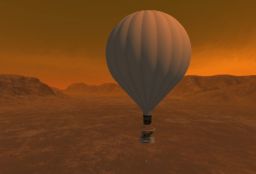Emily Lakdawalla • Aug 16, 2007
Ices, Oceans, and Fire: Conference overload
I am now back home from the icy satellites conference and still have a day and a half's worth of notes to digest. Hopefully I'll get to all of them this week. It was quite a dense three days to dive in to as my first conference since the arrival of the baby. I did try to cut back from the full conference schedule by not attending the evening sessions on either day. After the poster session on Monday, instead of attending two hours of "Flagship Study Briefings," I elected instead to go to dinner with my mother and daughter, and play with the kid for a little while, and give her a bath and put her to bed. After all that I decided to check back in on the conference room, and found that two hours into the two-hour session I was still in time for the last presentation and discussion.
The air in the room was tense, because of course nearly everyone has a very strong opinion on which outer solar system mission should be the next one; for most people in the room, the next flagship mission could well be the last flagship mission of their careers, so a lot is at stake. However, at the end of the session there was some happy discussion that I think is worth sharing. In the question-and-answer period, a European scientist stood and asked doubtfully whether NASA would invite cooperation with ESA for the next mission. Lately, cooperation between American and foreign space agencies has been incredibly difficult. But Fran Bagenal, the chair of the Outer Planets Assessment Group, stood up and had some positive things to say.
Paraphrasing Fran to the best of my ability: "Based on individual conversations I've had with Alan Stern and David Southwood in the last month, I have no doubt that there will be ESA-NASA cooperation on an outer planets mission." Alan Stern administers NASA's Science Mission Directorate, and David Southwood is ESA's Director of Science; they are in equivalent positions. "I also know that there is a lot of collaboration on the science team level. I am actually optimistic. There is a lot of understanding. There are issues of ITAR and so on, but there is a lot of collaboration. There's no doubt that there will be collaboration across the Atlantic." At this point Curt Niebur, who is the point person for outer planets at NASA Headquarters, said "I believe it was Southwood who said that 'we will either do a flagship together, or we will do a flagship together.'" Fran and Curt agreed that there was a lot of will to work together across the Atlantic at all levels. "It may seem a mess," Fran said, "but it will all work out in the end."
That wound up Monday, at 9 pm. On Tuesday, in an attempt to get through a day packed solid with talks, it appears I overdosed on caffeine. Quite suddenly, at about 4:45 pm, I was absolutely unable to take any more, and I had to leave the sessions, which was too bad because it was right in the middle of a very interesting presentation by Paul Schenk. Paul was kind enough to give me a copy of his presentation, however, so I can give you the gist of it later. So -- I'm now diving into my notes, and will hopefully surface a couple of times today and tomorrow with more from the conference.
Support our core enterprises
Your support powers our mission to explore worlds, find life, and defend Earth. You make all the difference when you make a gift. Give today!
Donate

 Explore Worlds
Explore Worlds Find Life
Find Life Defend Earth
Defend Earth


